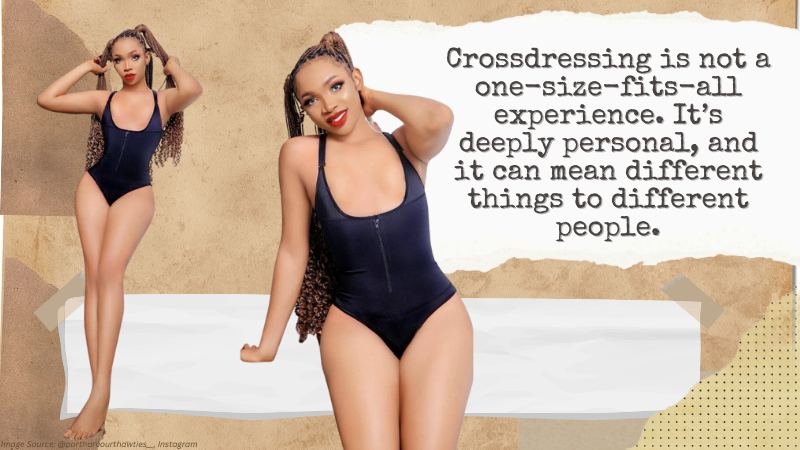What is a Crossdresser? Understanding the Identity and Practice
You enjoy crossdressing. But maybe feel confused or ashamed? This realization can be scary, and society's harsh judgment can make you feel alone, but you're not. You deserve answers.
Crossdressing is wearing clothes typically associated with a different gender. It can be enjoyed for self-expression, comfort, identity exploration, or even sexual pleasure.
Crossdressing doesn’t mean you're automatically trans or gay, though you might be. For many MtF crossdressers, dressing is about celebrating their feminine side. All without needing to change who they are.
Curious to understand what crossdressing really means — and what it doesn’t? Continue reading!
The Basics: What Does Crossdressing Mean?
Cross-dressing has a very simple explanation: It's "crossing over to the other gender's traditionally-linked clothing."
So, if you're a male-to-female (MtF) crossdresser, you may be wearing sleek long wigs, flawless makeup, or flowy dresses. Anything that screams "feminine," you know?
For female-to-male (FtM) crossdressers, it might involve suits, ties, or anything masculine.
But you have to know this now: Crossdressing is just dressing up. Crossdressing isn't the same as being transgender or any gender identity out there. It doesn't automatically have anything to do with sexual orientation, either.
Crossdressing is an expression. Sometimes it's just for fun, sometimes it's emotional, and sometimes it's intimate.
Oh, and by the way, the term “crossdresser” is more modern and respectful. This is compared to the older term “transvestite,” which has often been used in negative or derogatory ways.
If you want to start your crossdressing journey, Roanyer is the website for you. From cute outfits to customized silicone breasts or butts, you’ll find them all at Roanyer!
Why Do People Crossdress?
There's no one answer to this. Even the common answers listed below may lack the crossdressers' depth of reason. Everyone has their reasons, and it’s important to honor those differences.
So, here are some of the most common motivations:
1. Self-Expression
The most common, but also one of the most important reasons.
For many MTF crossdressers, dressing in femme clothes is a way to express a part of themselves. A part that doesn’t always get to shine in day-to-day life.
CDs say it's channeling your inner femme side, exploring creativity through fashion, or simply enjoying the act of changing your regular, dull look.
2. Comfort and Freedom
Only picking traditional clothes linked to a specific gender is so stifling. It's suffocating to just choose from one aisle when you can have the whole mall!
When you can wear what you want without regard to what gender wears what, your fashion options are endless. You can tailor everything to your taste.
It could be the texture of the clothing, the way it fits, or how it emotionally feels to you.
For instance, a man may have a silky nightgown and a pair of bras because they feel more "right" to him.
3. Sexual Pleasure
Sexual pleasure through crossdressing isn't as taboo as the media tries to make it. Many highlight this reason simply because of the intrigue it poses. The result? Many CDs are afraid of the assumptions and negative portrayals via these channels.
Though that may be, it's true that for some, crossdressing can be arousing or part of their sexual identity. There’s nothing wrong with that — it’s a valid experience.
But it’s also important to recognize that not all crossdressers do it for sexual reasons. Some do. Some don’t. And both are completely okay.
4. Exploring Gender Identity
Crossdressing is an accessible, easy way to explore gender in a low-pressure, private way. It might be an experiment, a question mark, or even a pathway (with GPS) to better understanding oneself.
Again, not everyone who crossdresses is trans. However, for some, it can be the first step toward discovering a different gender identity or expression.
The Difference Between Crossdressers and Transgender People
This is a big one. Many often confuse crossdressing with being trans, but they’re not the same thing.
Let's break things down to help clear things up:
Crossdressers:
They are generally comfortable with their assigned gender at birth
See crossdressing as a form of self-expression or personal exploration
Typically, do not wish to transition to another gender
May crossdress occasionally or regularly
Crossdressing doesn’t define the crossdresser's gender identity
Transgender People:
Experience gender dysphoria, a deep discomfort with one's assigned gender at birth
Crossdressing may be a part of their journey to explore their true gender identity
Often wish to transition — socially, medically, or both — to align their outer life with their inner identity
Being trans is about identity, while crossdressing is often more about expression
The main difference? Crossdressers dress to express. Trans individuals live to align with who they are.
Is Crossdressing Always for Sexual Pleasure?
Now, this is a question that pops up all the time. The short answer is: No, crossdressing is not always about sex.
As mentioned before, this stereotype is thanks to popular media's obsession with intrigue. It's hard to blame them, though. A crossdresser in search of sexual pleasure is more marketable and hooks more people in.
It’s true that for some people, especially when they’re first exploring crossdressing, it can have a sexual component. It might start as arousing or be part of a fetish. But for many, those feelings evolve.
It starts as sexual curiosity
It grows into something more personal or emotional
Some crossdressers discover something spiritual, too
Why? Because crossdressing can be calming, therapeutic, or empowering.
It’s a chance to unwind and to feel beautiful. It's connecting with a softer, more vulnerable side of themselves. Sure, sex can be part of it, but it’s not the whole story.
The Role of Crossdressing in Gender Fluidity and Non-Binary Identities
Crossdressing can also play a role for people who identify as non-binary or gender-fluid. What are those? These terms refer to those who don't feel fully male or fully female.
For these individuals, wearing clothes from different sides of the gender spectrum might be the best way to express who they really are.
Imagine mixing a bit of both worlds:
A lacy top with combat boots
A floral dress with short hair and a bushy brow
For many, crossdressing isn’t about becoming “the opposite sex.” It’s about blending both to reflect a truer self.
Through crossdressing, many can craft an identity that goes beyond “just male” or “just female.” It allows freedom to move between expressions. With crossdressing, you can play with gender and easily challenge the rigid norms society has set.
The Stigma and Social Perception of Crossdressing
Yes, it's still there! And there's a lot of judgment out there.
Crossdressers face stigma from all angles.
The classic misunderstandings between friends and family
The awkward questions from strangers
The hurtful stereotypes in the media
People often assume crossdressers are “perverts” or “just confused.” Others think crossdressing is just a kink or a phase. These ideas are not only inaccurate — they’re harmful, sometimes dangerous.
Know this: Crossdressing is a valid form of self-expression, and it deserves respect.
Everyone has the right to explore their identity. Why is it a problem to want to feel beautiful? Why is it an issue to dress in a way that reflects who you are inside?
It’s no different than someone putting on a tailored suit to feel powerful or slipping into a hoodie for comfort.
As a community, we need more education, visibility, and safe spaces. The more we share our stories and challenge the myths about crossdressing, the more acceptance will grow.
Conclusion
Crossdressing is not a one-size-fits-all experience. It’s deeply personal, and it can mean different things to different people.
For some, it’s a form of art. For others, it’s therapeutic. For many, it’s a blend of comfort, exploration, and joy.
To all the MTF crossdressers out there — whether you dress in secret, go out with a bang and unburdened passion, or are just starting to explore — you’re not alone. Your journey is valid. Your expression matters. And you deserve to live authentically, on your terms.










